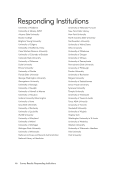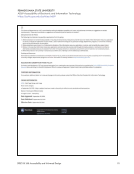5 SPEC Kit 358: Accessibility and Universal Design on at least some workstations at 50 of the responding libraries (83%) or double the number of institutions offering the next most common screen reader, Narrator. Forty respondents (74%) offer Kurzweil as another software option, with two noting in the comments that they offer multiple versions of it. Of the 44 respondents who offered speech recognition software, 36 (82%) offer Dragon Naturally Speaking. In the comments to this question, several respondents also identified built-in speech recognition tools on Microsoft and Apple devices. Many respondents offer access to word prediction and completion software, particularly Kurzweil and Read&Write Gold, as well. Specialized Hardware By far the most prevalent type of specialized hardware offered at workstations that have assistive technology is scanners with OCR capabilities, which are offered by 53 institutions (87% of respondents to this question), which is up from 42 institutions (79%) in SPEC Kit 321. The only other types of hardware offered at these workstations by a majority of respondents are speakers and microphones, which are each offered by 40 institutions (66%). Thirty-four respondents (65%) also offer desktop video magnifiers or CCTVs for use by patrons. When asked about other types of specialized equipment that they offer, multiple respondents mentioned tactile printers or 3D printers that could be used to create tactile objects and to print Braille. Interestingly, one institution also offers both white noise generators and full-spectrum lights. Far fewer institutions offer the option to borrow equipment for use outside the library. Only six institutions offer lending of these items through the library and only sixteen offer lending through other departments at their institution. However, 12 respondents did note that they might allow patrons to borrow items under certain circumstances. The majority of maintenance of library workstation hardware and software is done by library staff, though at about 40% of the responding institutions central IT and central ADA/disabilities staff also offer support for maintenance of hardware and software on library computers, particularly with respect to installation and troubleshooting. Some respondents indicated that they depend on the vendor to assist with maintenance and troubleshoot issues, as well. Web & Online Presence Accessibility Web accessibility is an important area for libraries given that so much library content is online, but despite the shared importance, it is clear that institutions take many different, widely divergent approaches to making their online presence accessible. For all types of online content, a significant number of respondents test accessibility only sporadically (53 or 83%), particularly vendor products, video captions, and multimedia content. A significant number also reported that they never check the accessibility of digital displays, social media, and library-created documents. However, some libraries do conduct accessibility tests regularly, particularly in the case of the library’s website. Nine respondents test the library’s website weekly and 13 test it monthly. A few respondents did note in the comments that they are moving towards workflows that would increase the amount of accessibility testing they do. One respondent also specifically mentioned that the library staff has worked with a visually impaired user to evaluate website accessibility. Respondents also differ on the criteria they use for web accessibility testing, though a clear majority responded that the criteria they use are level AA conformance to WCAG 2.0 (38 or 67%) and Section 508 compliance (34 or 60%). Respondents use a variety of tools to test web accessibility, with several mentioning that they use more than one tool. WebAIM’s WAVE was one popular option mentioned by multiple respondents. Based on responses to other questions in this survey that indicate that many institutions use their websites to advertise services that they provide to individuals with disabilities, it is particularly important that these websites are accessible.




























































































































































